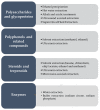Valorization of Mushroom By-Products as a Source of Value-Added Compounds and Potential Applications
- PMID: 32526879
- PMCID: PMC7321189
- DOI: 10.3390/molecules25112672
Valorization of Mushroom By-Products as a Source of Value-Added Compounds and Potential Applications
Abstract
Nowadays, the food sector is highly concerned with environmental issues and foreseen to develop strategies to reduce waste and losses resulting from activities developed in the food system. An approach is to increment added value to the agro-industrial wastes, which might provide economic growth and environmental protection, contributing to a circular economy. Mushroom by-products represent a disposal problem, but they are also promising sources of important compounds, which may be used due to their functional and nutritional properties. Research has been developed in different fields to obtain value added solutions for the by-products generated during mushroom production and processing. Bioactive compounds have been obtained and applied in the development of nutraceutical and pharmaceutical formulations. Additionally, other applications have been explored and include animal feed, fertilizer, bioremediation, energy production, bio-based materials, cosmetics and cosmeceuticals. The main purpose of this review is to highlight the relevant composition of mushroom by-products and discuss their potential as a source of functional compounds and other applications. Future research needs to explore pilot and industrial scale extraction methods to understand the technological feasibility and the economic sustainability of the bioactive compounds extraction and valorization towards different applications.
Keywords: applications; bioactive compounds; mushroom by-products; valorization.
Conflict of interest statement
The authors declare no conflict of interest.
Figures



References
-
- Manzi P., Pizzoferrato L. Beta-glucans in edible mushrooms. Food Chem. 2000;68:315–318. doi: 10.1016/S0308-8146(99)00197-1. - DOI
-
- Nakajima V.M., de Freitas Soares F.E., de Queiroz J.H. Screening and decolorizing potential of enzymes from spent mushroom composts of six different mushrooms. Biocatal. Agric. Biotechnol. 2018;13:58–61. doi: 10.1016/j.bcab.2017.11.011. - DOI
-
- Mirabella N., Castellani V., Sala S. Current options for the valorization of food manufacturing waste: A review. J. Clean. Prod. 2014;65:28–41. doi: 10.1016/j.jclepro.2013.10.051. - DOI
Publication types
MeSH terms
Substances
LinkOut - more resources
Full Text Sources
Medical

